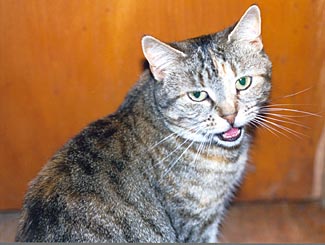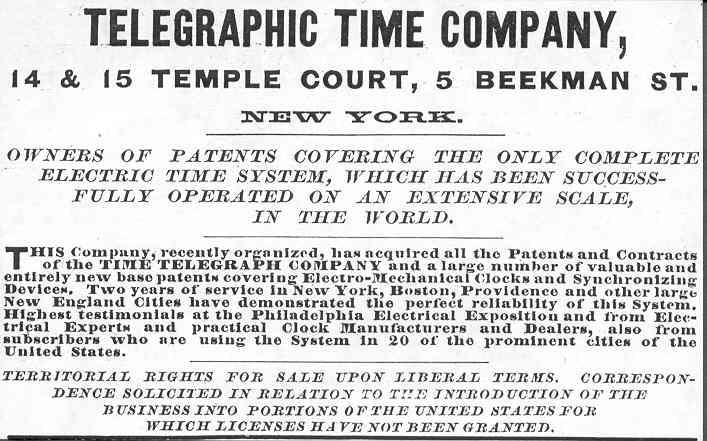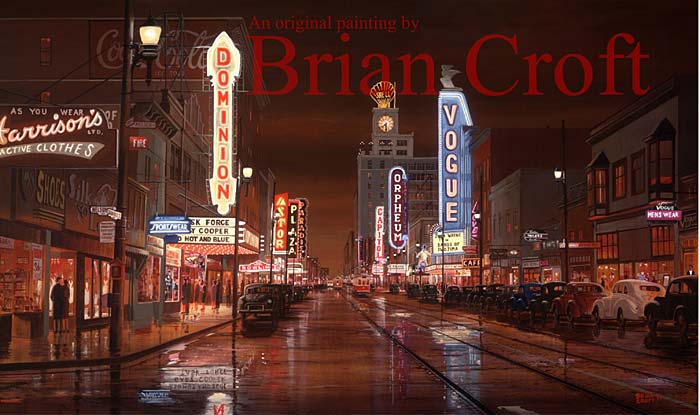






Written by C. A. Dow, Standard Electric Time Co. service technician, circa 1950:
I entered the employ of the S. E. T. Co. July 1, 1907 along with Annie Graham, a stenographer, both fresh out of High School.
The Boston Office at that time was at 35 Congress St., the Monks Bldg., Room 910. The telephone which they carried for quite a few years was Liberty-2904. Herbert H. Hammond had charge of the office with a serviceman by the name of Carl Sweetser. The Office was fitted out with a clock system designed to operate secondaries throughout the building which were rented for $10.00 a year. For this privilege we furnished a fancy marble dial in the entrance foyer of the building.
At that time there were not so many ways of checking the right time and I was given the job of getting it by checking on a large ball mounted on top of the Ames Bldg. At exactly 12 o'clock the ball would drop down the pole.
The younger Patterson came into the Company along about this time and was, for a short time, in Boston then went to the factory.
There certainly wasn't so much competition in those days as I can only seem to remember Blodgett, Howard and S. E. T. Co. in this district. The International Time came into the picture in 1909 when Mr. Hammond left us and went out to Endicott, taking with him all S. E. T. Co. ideas on electric clocks and a little later they came out with their first self winding master clock. It was as near a duplicate of the Standard as was possible using their plates and gears. At first they didn't have any definite ideas for secondary movements but tried two or three models and even bought out the Monarch Telephone of Chicago model, and used it for some years. Along about 1914 or 1915 they started to work on their 3 wire corrective. I even think the Standard must have started them on this as we had, up to then, changed a lot of spring driven recorders to magnet escape. Later we used #2 movements to drive them.
Hammond didn't stay long in Endicott as he was back with the Standard about 1911 or 1912, Carl Sweetser having taken over the office in the meantime, then leaving when Hammond came back.
Along in here I first ran into Chas. P. Fitz. He had desk room in our office and did a little telephone work. This is probably when he first contacted Mr. Riggs, which resulted in his going to Springfield.
It was about this time the Company decided to leave Waterbury for Foxboro. I know I spent a month or more in the building at Foxboro wiring it for clocks, watchman system, etc. before the factory moved in. Mr. Riggs established his office in Boston, adding Room 911 for his private office. Jenny Howland was his secretary. He lived on Garrison Road, in Brookline. I think he stayed in Boston until the factory went to Springfield.
In those years the clocks had not changed very much. The paper tape had come in whereas the Standard had been using a disc type mounted on a #1 movement. I don't think the Standard originated the paper tape as I have run old machines installed by Blodgett long before 1900. We did add, though, the automatic cut out periods as all the old Blodgetts were switch controlled. The last disc type I remember was taken out of the Lowell Teachers College about 1930.
About 1913 the Standard evidently got control of the Blodgett Company and for some reason it was not closed out immediately and the Boston office was moved into the Loft Bldg. at 141 Franklin St., where Blodgett did his manufacturing. For about a year and a half the Blodgett force and ours worked these together. During this time a mixture of Blodgett and Standard equipment went out. The office force was Mr. Blodgett and Mr. Atkinson, who later started the Atlantic Clock Co. When they closed out Blodgett, all Blodgett personnel got through, leaving Hammond, Jack Kirby, Miss Graham and myself.
The office was moved to the International Trust Bldg. on Milk St. It was here the older Patterson was working under Hammond for a while. The office only stayed here a short time and moved to Franklin St. corner of Oliver.
World War I came along, Kirby went in the service, Miss Graham went to work for the Government and Miss Linquest took over the stenography and Mr. Hammond got through for the last time. The first service auto, an open Ford runabout, showed up although Mr. Hammond used it altogether.
A Mr. Waterhouse, about 1918, then took the office but didn't last long after which Mr. Parker and Charlie Olson came into the picture.
The office moved to 93 Federal St. Kirby came back from the war and the office again moved to 10 High St., fourth floor. After a while Parker got through and Kirby took the Office. In 1922 I got my first service auto, a model T. Ford. Since then I've lost track of the cars, but think the present one is the 14th, Fords, Dodge, Pontiacs and Chevrolets. After Kirby took over he brought Phil Dorne in to help him.
I believe about 1925 the need of corrective clocks showed up so of course the clocks changed quite a lot, from the first resistance controlled 2 voltage 2 wire clock down through constant service systems to the present 3 wire and 2 wire systems.
Kirby died in 1927 and several men had the office, including Mr. Blake and Mr. Angiers. After Angiers, Dorne took over the office which was moved to different rooms at 10 High St. twice, the second time where we are at present. We never have had much exhibition equipment in this building and it still is a pretty poor sample of S. E. T. equipment.
During the depression years Charlie Olson and I had enough work to give us half time for four or five years and managed to get by but it was tough going.
Olson died in 1939 and we sure lost a good man. Charlie was peculiar in lots of ways but we always managed to get around our troubles somehow. He didn't start to drive a car till 1929 but from then on he used one. After his death the service troubles in the Boston office began. In the 11 years since it is really remarkable that some of the systems will still operate after the variety of mechanics that have worked out of the office. The present one seems more of the right type.
Dorne got through in the early forties and during the first part of the late war quite a variety of men were tried out in the office until Chester Greenwood took over and managed to get things moving.
Miss Crawford got through and Miss Bailey arrived, so now with Mr. Greenwood and Hasselbaum the office seems more stable than it has been for a long time, looking backward 43+ years is a long time to recollect very many intimate details.
C. A. Dow


My name is Brian Croft and I am an artist doing historical paintings of Vancouver Canada. I recently completed a circa 1950 painting of Granville St. in Vancouver, a night scene which includes the "Vancouver Block" and its SETCo fitted Clock tower. I depicted the clock as backlighted but of course today the clock is rather garishly lit with red and blue neon.
My painting, "Theatre Row, Granville Street - 1950", looks north on Granville from Nelson St. I chose January 26, 1950 as the night I would paint. Archived back issues of the Vancouver Sun's entertainment section, provided precise data on the entertainment scene on that night thus the movie titles that appear on the marquees are as accurate as possible. I used more than a hundred researched images to add detail upon tiny detail.
At the Dominion, Gary Cooper stars in "Task Force", while last year's hit "Red Hot and Blue" completes the double bill. Across the street, the Vogue is selling John Wayne in "Sands of Iwo Jima". The Orpheum boasts "Jolson Sings Again" starring Larry Parks. The fresh comedy of Danny Kaye in "Inspector General" is playing at the Capitol. Also playing on the strip tonight: "Abandoned" at the Plaza, the last showing of "Zamba, Terror of the Jungle" is at the Paradise, and at the Studio, "Lost Boundaries" in its 5th record week.
I painted the Vancouver Block tower clock, absent today's garish red and blue neon, and place the clocks hands at 7:30; this is actually between shows at most theatres and so, rather than depicting line-ups, I painted patrons checking out marquees and grabbing a quick supper at the countless cafes. I included two streetcars working in opposing directions down Granville Street bringing people to the heart of Vancouver's entertainment district. By 1950 electric trolley busses had already begun operating and so at the far end of the street, pulled over to accept passengers, a tiny brand-new "Brill" trolley bus is included.
This painting is just part of Vancouver's night scene. Around the corner on Hastings, the entertainment district to the east and west of Carrall are just as busy. The main nightspots are in full swing this evening; Mel Torme, dubbed "the Velvet Fog", is performing at the Palomar Supper Club and Billy Eckstine is at the Cave. On Granville, The Aristocrat with its distinctive neon sign dominates the cafe's and eateries but a few miles further south, at Granville and 67th Avenue, White Spot was the place-to-go if you had serious dinning plans. It was a "must-do" kind of thing for performers and celebrities after The Cave, The Palomar and other showrooms closed. Jack Benny, Bing Crosby, Wayne and Schuster, Dennis Day, Mary Livingstone, Henry Mancini, Robert Goulet, Van Johnson, Dal Richards, Mel Torme and a host of others gravitated to the south end of Granville for a taste of White Spot restaurant excellence. My painting, "White Spot - 1958" chronicles the White Spot experience.
A painting like this can be a daunting undertaking. So many big and little decisions such as researching or choosing colours, filling in gaps where no amount of investigation could tell me what to paint. As always, my brush strokes were guided by history and only later, after all sources were exhausted, did I employ artistic license to achieve a finished work. Thus it was my imagination that created places like Flag Shoes, Silk and Lace and Sharon's etc. It was such a delight to light-up Granville street's theatre marquees once again casting them against a brooding night sky. Even more fun to create mirrored reflections in the pavement suggesting the recent passage of a January evening shower. I can only hope it takes you back to that special time in your past when, with five bucks in your pocket, and a special person by your side, Theatre Row on Granville was a night on the town.
~ ~ ~ ~ ~ ~ ~ ~ ~ ~ ~ ~
Jeffrey R. Wood, creator of the Standard Electric Time Co. (SETCO) pages of clockhistory.com, passed away in August of 2018. I will maintain the SETCO web pages in honor of Jeff, but will not be making any additions or changes, or answering any questions. It is hard to express how much I miss Jeff, his friendship, and his wonderful contributions to Standard Electric and Westclox research.
Bill Stoddard